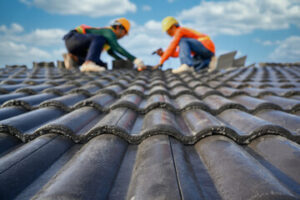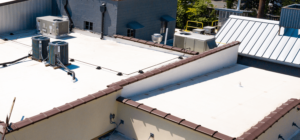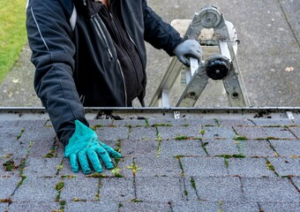Roofing installation involves attaching a new roof to a building. This protects the building’s occupants from weather conditions and ensures longevity of the structure.

Before hiring a roofing contractor, research their experience and reputation. You should also verify their licensing and insurance status. Additionally, you should make arrangements to have your pets kept indoors during the process, as hammering can be disruptive to them. Visit Website to learn more.
Getting a new roof is a big project that requires specialized skill and knowledge. It’s important to have the right contractor on board who can walk you through all of the steps and prepare your home for a successful installation. Preparation is key to making sure the job goes smoothly and your investment is protected.
Clearing the area around your home is a must before the roofing process begins. If you have children’s toys, bikes, or patio furniture close to your house, move them out of the way. These items can be tripped over or damaged by falling debris during the roofing job. Clearing the area also gives the roofers space to work without tripping or stepping on anything that isn’t supposed to be there.
The vibrations caused by hammering on the roof can damage items hanging on the walls of your home, especially those made from glass or metal. This can include mirrors, paintings, framed photos, and other delicate objects. If you have items that aren’t easily moved, it’s a good idea to leave them at a friend or family member’s house during the roofing process.
Before beginning the roof installation, a professional should walk the grounds and the roof to make note of any areas that need special attention. They should also check for any leaks or cracks that may need to be repaired. This will help ensure that the finished roof is in good condition and protected from the elements.
Another item to keep in mind is waterproofing the valleys of your roof. These are the areas where your roof slopes meet and form a “V” angle. The valleys are prone to water run-off, so it’s important to ensure they are waterproofed. This can be done by adding a layer of underlayment and felt paper. It’s also a good idea to add extra layers of shingle over the valleys to prevent water from seeping into your home. Waterproofing the valleys will also help protect your home from ice dams during colder weather.
Materials
The choice of roof material is an important part of a roofing project, adding to the style and value of your home. There are many different options to consider, and a top-tier roofer will help you choose the best materials for your goals, climate and budget.
Asphalt shingles are the most popular roofing material, but you have other options as well. Tiles are a beautiful option, and you can get them in an array of colors to complement your house. Metal roofs are also becoming more common, and they are durable and fire-resistant. Slate is an attractive, natural roofing material that can last upwards of 100 years. It’s heavy, though, and requires a more specialized installation method.
For flat and low-pitch roofs, rolled roofing is an economical choice. It comes in large rolls and is fastened to the deck with either a torch-down method or roofing nails. If you’re going with rolled roofing, it’s a good idea to install an underlayment to protect against leaks and snow buildup.
Flashing is a protective layer that’s installed around chimneys, joints and other spots that might let water in. It’s important to have this in place, and a good roofer will do it properly to keep your home safe.
Another way to keep water from entering your home is by waterproofing the valleys, where the slopes of your roof meet. This is usually done with specialty material.
Before you start any work, make sure to have all the proper tools and supplies for the job. You’ll need pry bars to remove any nails or staples holding down old roofing materials, as well as a ladder and safety equipment. A hard hat, eye protection and gloves will all ensure your safety while you’re working on the roof.
For your convenience, a roofing supply store will carry the necessary materials for your project. They’ll be able to advise you on any additional gear you might need for your specific project, like tin snips for cutting gutter materials or a caulking gun for applying roofing cement. These tools will allow you to do a better job and save time by not having to go back and forth to the hardware store.
Installation
Unlike smaller home improvement projects, like painting or patching, roofing is not something that the average homeowner can take on themselves. In fact, it is dangerous and should only be left to a professional. If you’re going to be getting your roof replaced, here are a few things that you can do ahead of time to make the process as smooth and safe as possible.
Clear outdoor toys and patio furniture: Roofing professionals will need to walk all around your house to access the roof, so it’s best to have a 15-foot clearance for safety. Also, be sure to mark any koi ponds or other water features so they aren’t accidentally stepped in.
Finally, trim your grass: It’s much easier for roofers to see any nails or other debris in short grass than it is on tall weeds.
Final Inspection
The final inspection is an evaluation of the quality and safety of a product, structure, or service. It ensures adherence to industry-specific standards, mitigating the risk of costly non-compliance penalties. This step is essential in the production process and ensures that a project is complete and ready for a client’s satisfaction, whether it’s a new construction or a food services facility.
Developing a comprehensive final inspection checklist requires careful consideration of the specific requirements of each project and industry. To create a robust checklist, start by reviewing the inspection specifications and plans to identify all of the specific elements that must be evaluated during the final inspection. Then, assign individual roles and responsibilities for completing and verifying each item on the checklist. This will help to streamline the inspection process, minimizing confusion and ensuring that all steps are completed in the correct order.
A detailed final inspection checklist is instrumental in minimizing errors and ensuring that all regulatory requirements are met. It acts as a record of all the components that must be inspected and approved by a qualified inspector, allowing for meticulous compliance monitoring and preventing any misunderstandings between teams. Additionally, a thorough final inspection checklist promotes accountability and ensures that all necessary steps are taken to meet industry standards and client expectations.
Once the roof is complete, the roofing technician will perform a final inspection of the sheathing and exterior trim to make sure that they’re in good condition. They’ll also evaluate the roof decking to ensure that it is sound and doesn’t show signs of damage. They will also make sure that all flashings and drip edges are in place and properly installed. Finally, they will check that all nails and screws are properly secured and the sheathing is properly attached to the joists and trusses.
Using an integrated software solution can drastically reduce the time spent preparing for and conducting a final inspection. These tools can automate the data collection and analysis, reducing human error and facilitating a faster, more thorough inspection. Moreover, IoT technology allows for real-time data to be directly fed into the final inspection checklist, enabling a seamless integration of technology with inspection processes.



